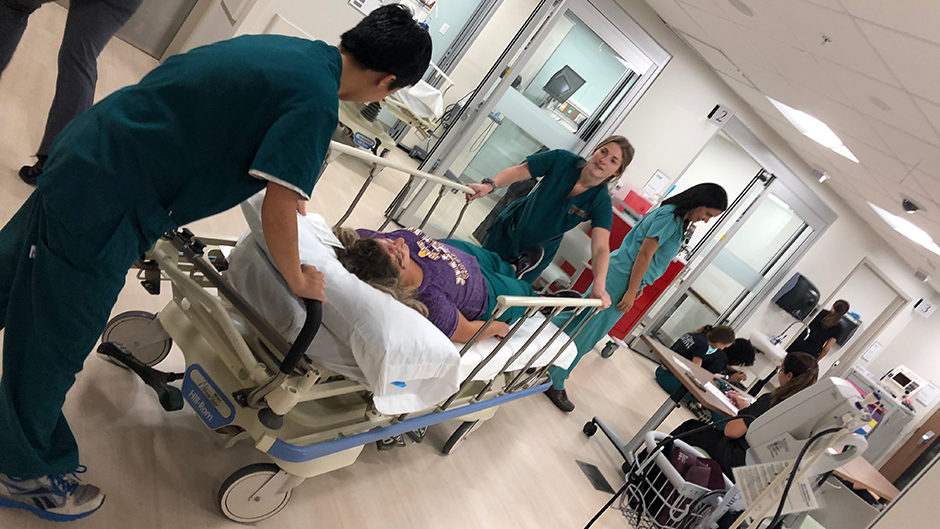Just a few weeks after the start of the Atlantic hurricane season—which begins Saturday—nursing, public health, and medical faculty, staff, and students will gather for three intense days to simulate the humanitarian response to a natural disaster.
Fittingly, the first interdisciplinary course of its kind to be held on a college campus will unfold at the University of Miami School of Nursing and Health Studies (SONHS), which even before opening its Simulation Hospital in 2017 regularly conducted mass casualty simulations to prepare students to cope with and respond to expected and unexpected catastrophes.
“It’s important because it’s not a matter of if—it’s a matter of when,” said Susana Barroso-Fernandez, director of Simulation Hospital Special Projects, who is helping plan the June 28-30 exercise led by Humanitarian U, an organization that provides professional certification and training to humanitarian workers worldwide.“This is real life, and this is going to happen.”
Although disaster response is more often associated with police officers, firefighters, and emergency medical technicians who converge after storms, terrorist attacks, shootings, epidemics, or accidents, the vital role nurses play in such incidents has been increasingly recognized. That’s why the World Health Organization and the American Association of Colleges of Nursing began pushing for disaster nursing training to be incorporated into nursing education, and why SONHS stepped up to the plate.
The school now stages a full-scale disaster simulation each fall and spring semester. The first one took place in 2014 on Ebola, during the outbreak of the deadly hemorrhagic virus in Africa. The latest was in mid-April, with an eye on the fast-approaching 2019 hurricane season.
Assuming the roles of nurses or evacuees who were injured during a massive storm, 118 undergraduate nursing students, faculty, staff, graduate students, and community volunteers created a number of real-world situations in the Simulation Hospital’s auditorium and Medical-Surgical Unit. Each was designed to test how nurses would react in a “surge” situation, where health care professionals must treat a sudden flood of patients needing medical attention, triage, treatment, and even surgery.
“I don’t think students get how overwhelming it can be without actually experiencing it and having a bunch of individuals screaming at you, injured in pain, and moaning,” said SONHS assistant professor Yui Matsuda, who helped facilitate the April exercise for her public health nursing students. “This opportunity gives them the chance to see what it’s like.”
As the storm supposedly raged outside, the students who portrayed nurses tried to maintain calm inside a makeshift emergency shelter filled with distraught people with various needs. Among them: an elderly shelter resident who lost his cane, an irate woman who needed her medication, and a group who had contracted an intestinal illness.
Nearby, the emergency room, which had lost half its beds during the storm, was beyond capacity. But that didn’t stop hurricane survivors from pouring in. They included a pregnant woman who went into premature labor, another who fell off her roof, and an agitated father who was far more worried about his missing son than the bloody gash on his head.
In the incident command center, Rachael Socarras, a student in SONHS’ Family Nurse Practitioner Program who is an ER nurse at Jackson Memorial Hospital and a member of the Medical Reserve Corps, oversaw eight undergraduates assigned to simulate coordinated management of the emergency.
“I was so excited to see the University is taking steps to prepare our undergraduate nursing students in being first responders,” said Socarras, who for the corps has been trained to respond to hazmat disasters, terrorist bombings, and Ebola outbreaks. “UM’s students are being provided with a unique experience that is further preparing them for the workforce they will be entering as new nurses.”
The students don’t go into simulations unprepared. Their public health nursing curriculum also includes Federal Emergency Management Agency trainings and lectures addressing disaster nursing issues such as triage methods, health impacts, and stages of response.
“What we put in these scenarios isn’t far-fetched,” said Barroso-Fernandez, assistant professor of clinical, who organized the hurricane simulation. “It’s very close to the real world.”
Barroso-Fernandez can’t say what participating students, faculty, and staff will face during next month’s simulated humanitarian crisis, which is sponsored by SONHS and the Miller School of Medicine’s Gordon Center for Research in Education and Global Institute for Community Health and Development.That looming disaster is a carefully guarded secret because, as in real life, first responders often have no idea what’s coming but must be prepared to act swiftly, safely, and knowledgably.
“This is unlike anything we’ve ever done before,” Barroso-Fernandez said. “The goal is to have students prepare to deploy and participate in an active humanitarian relief situation. This is the focus. But we’re not telling them what to prepare for because, unfortunately, that’s not the real world.”
For a full account of April’s hurricane simulation, see Weather-Ready Responders.

